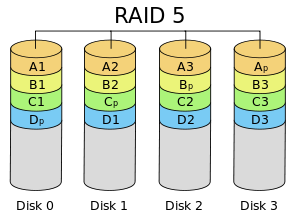I know that RAID-5 consists of block-level strippingstriping across multiple disks, but using an additional parity-check block on each disk .. and that at least two disks are required for strippingstriping.
And it's obvious that each parity block is specific to each disk it belongs to (and so there is no need for allocating an additional disk).

Image from Wikipedia.
However I've been unable to understand why in fact there is an additional disk required for parity checks, as I found on this article:
The minimum number of disks in a RAID 5 set is three (two for data and one for parity).
Any idea?
